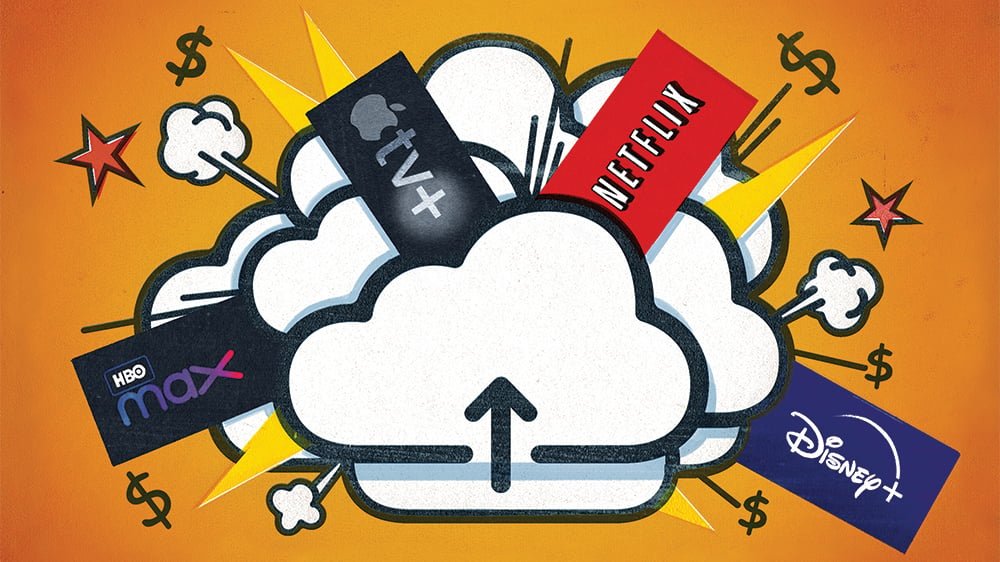Media companies both old and new had pinned their hopes on riding a wave of interest in streaming well into the future. Now they are finding that there may be only so far the new technology can go.
Netflix’ disclosure on Tuesday that it lost 200,000 subscribers in the first quarter and expects to lose 2 million more in months to come, has set the industry on edge — not because Netflix is a barometer of entertainment-sector health, but because it is furthest along the path that rivals ranging from Apple to Warner Bros. Discovery are all treading. In an era when more consumers want to watch their favorite programs at times of their own choosing, every media conglomerate and new-tech Hollywood hopeful has reworked itself into an organization focused increasingly on streaming, rather than the linear TV that is still the core of the overall business.
And on Tuesday, all that work came under new scrutiny.
To be sure, Netflix’ subscriber shortfall comes during a unique period, one in which many U.S. companies are cutting ties with consumers in Russia and when pandemic patterns may have taken an outsize hold on how media companies operate. But there are other signs that when it comes to signing up for new streaming subscriptions, consumers have started to buffer.
CNN+, the new streaming service from the popular news outlet, is likely to be scaled back dramatically, according to people familiar with the matter, as the company’s new corporate parent, Warner Bros. Discovery, looks to focus more intently on a single streaming portal that combines Discovery+ and HBO Max. Warner Bros. Discovery has already cut the marketing budget for CNN+, one of these people said, though its shows remain in production.
How much wider can people open their pocketbooks and wallets for streaming? Penetration of subscription video-on-demand services stood at 81.4% in the first quarter of 2022, according to Kantar, compared with 81.6% in the last quarter of 2021. Ad-supported streaming services continue to grow, according to the market-research firm, but that too is slowing. Penetration of ad-supported services stood at 25.3% in the first quarter, compared with 24.4% at the end of last year.
Simply put, the nation’s leading streamers may have reached an intriguing new phase: maturity. “We are seeing growth in new subscriptions at new services like Peacock and Paramount+ versus the more established services of Netflix, Hulu, Disney+ and Amazon,” says media analyst Michael Nathanson in a Wednesday-morning research note.
Love Film & TV?
Get your daily dose of everything happening in music, film and TV in Australia and abroad.
And that will force other media companies to answer questions about their streaming efforts, all of which have been under Wall Street scrutiny for months. Disney, Comcast and Paramount Global have all in recent quarterly calls with investors been grilled either over the projections of subscriber growth and content spend they provide, or for a lack of doing so. With Comcast and Warner Bros. Discovery expected to deliver earnings reports next week, those inquiries are likely to continue to rise. Investors may now be wary of those companies, as well as Roku, suggests Jeff Wlodarczak, an analyst with Pivotal Research Group.
“For media companies, successfully moving from traditional pay-TV to direct streaming is key and Netflix results imply that with the industry leader already at full penetration, the road to direct will be harder and materially more expensive,” he said in a research note Wednesday.
Media companies don’t have any easy cure-alls within reach. Netflix, for example, articulated plans to both crack down on households that share passwords and to launch an ad-supported tier, much like its more direct competitors like Disney and HBO Max have done. Such plans may not bear immediate fruit. “Netflix may be able to squeeze a few more dollars out of some of the primary households, but we think that other ones will look at the new sharing fee as another pricing increase and cancel,” Morningstar senior equity analyst Neil Macker says in a research note.
Advertising, meanwhile, will take some time to attract. Netflix will need to develop a sales team, build stronger ties with Madison Avenue media-buying agencies, and do something even more daring. Sponsors will demand to know how many subscribers saw their commercials, and what kind of consumers they are. Marketers may also press Netflix to guarantee a certain level of viewing and impressions, or even to tie a commercial to a particular business outcome, like a visit to a car showroom or the purchase of a movie ticket. This may force executives at Netflix into levels of disclosure to which they are likely not accustomed.
The media world’s streaming wars have already forced wrenching change, including two massive mergers between WarnerMedia and Discovery and CBS, and Viacom. Other companies, like NBCUniversal and Disney, have reorganized themselves to follow their consumers into the broadband world. The challenge, of course, is that no executive is certain whether any of these corporate maneuvers will ultimately bear fruit. If Netflix, the pioneer in streaming, is facing heady challenges, imagine what could be in store for those who follow.
From Variety US































